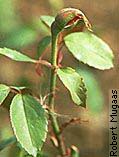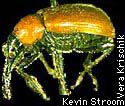
Photo 16: Rose midge damage to a bud.
Rose midge (Dasineura rhodophaga)
Identification
 Photo 16: Rose midge damage to a bud. |
Scouting
Feeding by the larvae causes bent, misshapen, or blasted buds and withering stem tips. Flower buds and growing shoots turn brown and finally black. with a magnifying lens, look for the small whitish larvae between the petals and sepals at the base of the flower bud to verify the presence of midge larvae.
Control
Prune out these infested buds to remove the larvae, reducing the number of midges available to reinfest the plants. Midge damage is often noticed after July. Chemical control is needed for persistent problems. Systemic insecticides are the best choice. Acephate (Orthene) and dimethoate (Cygon-2E) are systemic chemical controls. Be sure to get good coverage of flower buds.
Rose curculio (Merhynchites bicolor)
Identification
The adult rose curculio weevil is reddish in color with a long snout. The head, snout, legs, and underside are black. Adults are approximately 3/16 inch (6 mm) in length.
 Photo 17: Rose curculio. |
Control
Hand pick adults if few in number. When bothered, adults fall from the plant. Therefore, gently shake canes over a bucket or tray to collect fallen adults. Prune out and remove finished flowers to remove larvae, which can help reduce future problems. Conventional insecticides include carbaryl (Sevin), acephate (Orthene), and chlorpyrifo (Dursban).
| HOME: Insect Pests of Roses | NEXT: Gall makers |